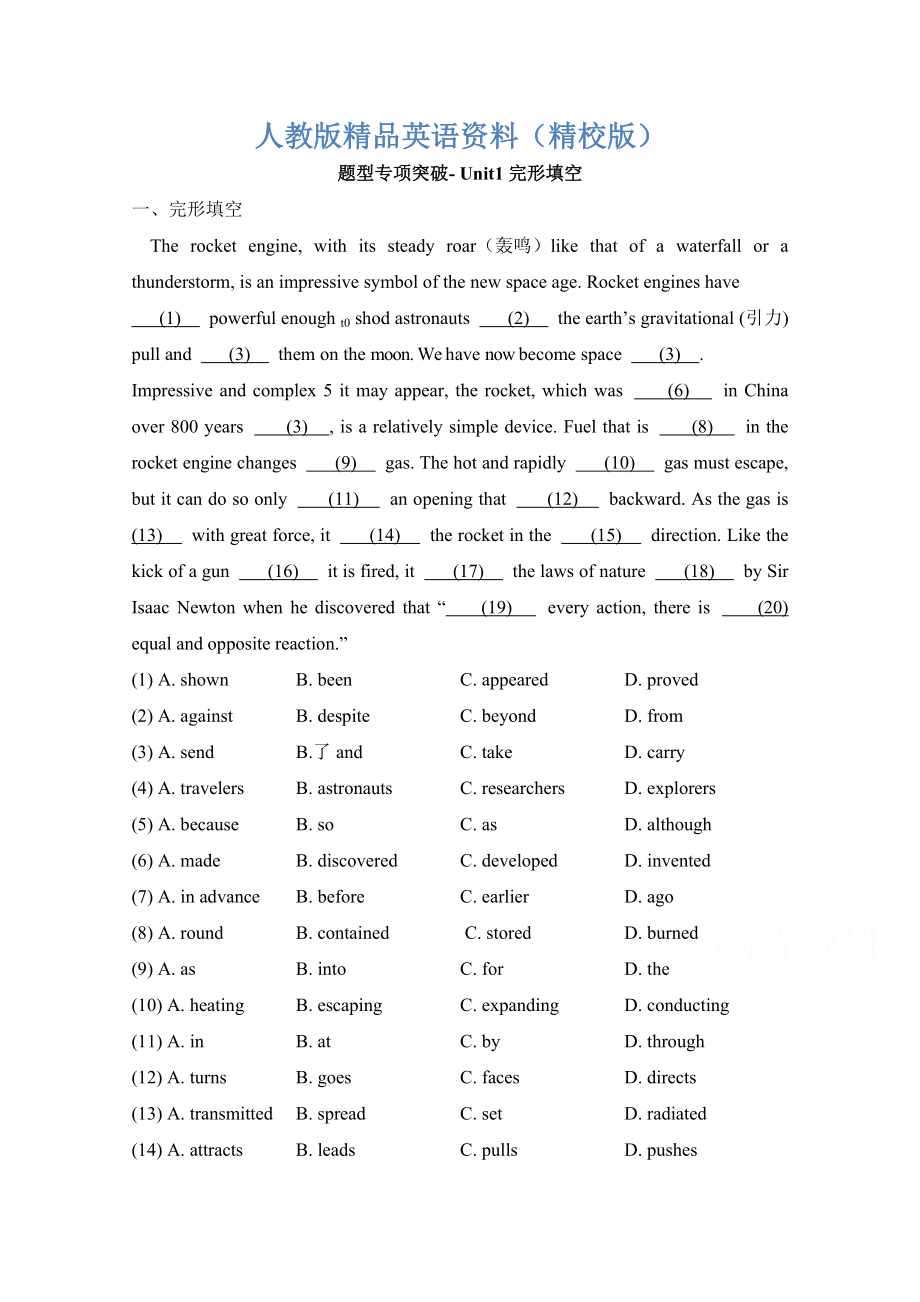《【精校版】人教版高中英語必修五 Unit1完形填空科技篇 題型專項(xiàng)突破 Word版含答案》由會員分享��,可在線閱讀����,更多相關(guān)《【精校版】人教版高中英語必修五 Unit1完形填空科技篇 題型專項(xiàng)突破 Word版含答案(3頁珍藏版)》請?jiān)谘b配圖網(wǎng)上搜索�����。
1、人教版精品英語資料(精校版)
題型專項(xiàng)突破- Unit1完形填空
一�、完形填空
The rocket engine, with its steady roar(轟鳴)like that of a waterfall or a thunderstorm, is an impressive symbol of the new space age. Rocket engines have
(1) powerful enough t0 shod astronauts (2) the earth’s gravitational (引力) pull and (3)
2、 them on the moon. We have now become space (3) .
Impressive and complex 5 it may appear, the rocket, which was (6) in China over 800 years (3) , is a relatively simple device. Fuel that is (8) in the rocket engine changes (9) gas. The hot and rapidly (10) gas must esc
3��、ape, but it can do so only (11) an opening that (12) backward. As the gas is (13) with great force, it (14) the rocket in the (15) direction. Like the kick of a gun (16) it is fired, it (17) the laws of nature (18) by Sir Isaac Newton when he discovered that “
4���、 (19) every action, there is (20) equal and opposite reaction.”
(1) A. shown B. been C. appeared D. proved
(2) A. against B. despite C. beyond D. from
(3) A. send B.了and C. take D. carry
(4) A. travelers B. astronauts C. researchers D. explorers
(5) A. because B. so C. as D. alth
5��、ough
(6) A. made B. discovered C. developed D. invented
(7) A. in advance B. before C. earlier D. ago
(8) A. round B. contained C. stored D. burned
(9) A. as B. into C. for D. the
(10) A. heating B. escaping C. expanding D. conducting
(11) A. in B. at C. by D. through
(12) A. turns B
6���、. goes C. faces D. directs
(13) A. transmitted B. spread C. set D. radiated
(14) A. attracts B. leads C. pulls D. pushes
(15) A. same B. other C. opposite D. wrong
(16) A. that B. when C. if D. although
(17) A. states B. proves C. follows D. breaks
(18) A. described B
7、. discussed C. considered D. made
(19) A. Like B. As C. With D. For
(20) A. no B. an C. another D. the
答案:
(1)-(5) DCBAC (6)-(10)DDDBC (11)-(15) DCDDC (16)-(20)BCADB
解析:
(1) 根據(jù)空后形容詞powerful作表語可推知�,此處應(yīng)選系動詞proved,意為“證明是”。been和appeared雖可作系動詞但與句意不符��,故排除�。
(2) 根據(jù)powerful enough to sho
8、ot astronauts可以判斷是“超出地球的引力”�,故選beyond,意為“超出,超過”��。
(3) 根據(jù)后面的on the moon可知選land,固定短語land…on意為“使……著陸”�。
(4) traveler意為“旅行者”����;astronaut意為“宇航員”�;researcher意為“研究者”���;explorer意為“探險者”�。聯(lián)系上下文可知��,此處用space travelers最合適��,表示“太空旅行者”���。
(5) 此處是表示讓步狀語從句的狀語從句�����,而且是一個倒裝句��,故選連詞as��。連詞although不用于倒裝句中�,故排除D項(xiàng)���。
(6) make意為“制造”�;discover
9、t意為“發(fā)展”����;invent意為“發(fā)明”。根據(jù)語境可以看出����,此處用invented最符合,句意為“在中國��,火箭是800多年前被發(fā)明的”����。
(7) 表示“多少年以前”要用ago, over 800 years ago意為“800多年前”。
(8) fuel被燃燒才能變成gas,故選burned�。
(9) 此處表示“變成氣體”,故用固定短語change into�。
(10) 根據(jù)常識可知,此處應(yīng)選expanding gas, 意為“膨脹的氣體”�。
(11) 膨脹的氣體只有通過一個出口才能逸出,故選 through, 意為“穿過�,通過”。
(12) 此處為定語從句�,意為“朝后的出口”,故
10、選 faces,意為“朝著”�����。
(13) 這里表示當(dāng)氣體被用力放出時���,故選radiate, 意為“發(fā)射,射出”�����,其他三項(xiàng)都不符合語境���。
(14) 根據(jù)常識可知�,火箭發(fā)射時要依靠噴出的氣體 給它推力���,故選push,意為“推”���。
(15) 根據(jù)常識可知,火箭與放射出的氣體是相反的�,故用opposite,in the opposite direction 意為朝“相反的方向”�����。
(16) 此處用when引導(dǎo)時間狀語從句,意為“當(dāng)開槍時”���。
(17) 此處意為“遵循自然規(guī)律”����,故選follow��。
(18) 此處用described做后置定語��,意易 “被牛頓描述的”�����。
(19) like表示“如同”�;as表示“例如”;with表示“隨著”�����;for表示“對于”�。根據(jù)語境可知選for合適。
(20) 句意為“每個作用力都有一個相等的反作用力”�����。此處表示泛指,故選an�。
 【精校版】人教版高中英語必修五 Unit1完形填空科技篇 題型專項(xiàng)突破 Word版含答案
【精校版】人教版高中英語必修五 Unit1完形填空科技篇 題型專項(xiàng)突破 Word版含答案

